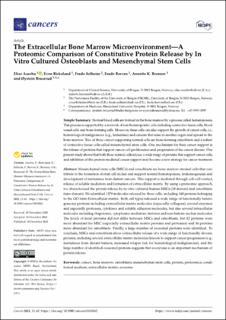| dc.description.abstract | Mesenchymal stem cells (MSCs) and osteoblasts are bone marrow stromal cells that contribute to the formation of stem cell niches and support normal hematopoiesis, leukemogenesis and development of metastases from distant cancers. This support is mediated through cell–cell contact, release of soluble mediators and formation of extracellular matrix. By using a proteomic approach, we characterized the protein release by in vitro cultured human MSCs (10 donors) and osteoblasts (nine donors). We identified 1379 molecules released by these cells, including 340 proteins belonging to the GO-term Extracellular matrix. Both cell types released a wide range of functionally heterogeneous proteins including extracellular matrix molecules (especially collagens), several enzymes and especially proteases, cytokines and soluble adhesion molecules, but also several intracellular molecules including chaperones, cytoplasmic mediators, histones and non-histone nuclear molecules. The levels of most proteins did not differ between MSCs and osteoblasts, but 82 proteins were more abundant for MSC (especially extracellular matrix proteins and proteases) and 36 proteins more abundant for osteoblasts. Finally, a large number of exosomal proteins were identified. To conclude, MSCs and osteoblasts show extracellular release of a wide range of functionally diverse proteins, including several extracellular matrix molecules known to support cancer progression (e.g., metastases from distant tumors, increased relapse risk for hematological malignancies), and the large number of identified exosomal proteins suggests that exocytosis is an important mechanism of protein release. | en_US |

